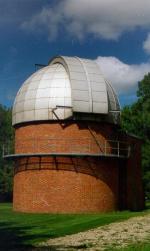| Warner and Swasey Observatory |
| Case Western Reserve University | Nassau Station |
| Visitors |
|
» Home » News » Gallery » Reference » Weather |
| Science Resources |
|
» NSRT User Interface » Software » Data Archive » Download Data |

|
 |

Since their laboratory is the sky, astronomers have to contend with the fits of Mother Nature when doing their observations. A cloudy night is an astronomer's worst nightmare if data needs to be taken. Not just clouds, but the atmosphere itself is an obstacle when trying to make accurate observations. The atmosphere scatters some light, and generally bends and distorts waves of light. Diffraction and distortion of light waves from a star or other luminescent object causes a lack of convergence into a single point source once the image has gone through the telescope's lens.

It is a general assumption that the higher the magnification of a telescope, the farther and better it can see. This is true only to a certain point. The aperture becomes much more important once the effects of refraction set in.
Terminology
Airy disc: the disc-like image of a planet or star (or any point source) which is seen through an optical system with a circular aperature. The majority of the light from the object is within this disc, and this is what limits the resolving power of a telescope.
Aperture: in a refracting telescope, this is the diameter of the objective lens; in a reflecting telescope this is the diameter of the primary mirror. The light gathering power depends on the square of the aperature.
 Dawes limit: the angular resolution of a telescope, dependant on the wavelength (lambda) of light being observed, and the aperture of the telescope (D, in cm).
Dawes limit: the angular resolution of a telescope, dependant on the wavelength (lambda) of light being observed, and the aperture of the telescope (D, in cm).
Diffraction: the observable bending of light that takes place around objects and creates dark and light bands (interference fringes).
Hubble Space Telescope: a 2.4 meter reflecting telescope which takes various data from space. It is not an especially large telescope; the reason that it is important is because it is above the atmosphere in low earth orbit, so its resolution is ten times better than that of a telescope on earth.
Refraction: the bending of light that takes place at the interface of two different media such as air and water or air and glass. This happens because the wave velocity changes when it enters the new medium.
Resolving Power: the smallest angle separating two objects where the objects are identifiably distinct. The magnifying power of the telescope determines this on a large scale, but once refraction effects set in, the aperture becomes very important.

Seeing: the quality of the conditions when observing rated on the Antoniadi scale from perfect to appalling. Atmospheric conditions (turbulence, clouds) determine how good seeing is at any time. Seeing imposes the greatest limitation on a telescope.
Back to the NSRT Reference page
Created by Marta Lewandowska, June 1999.